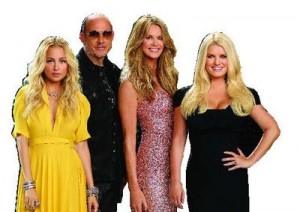



“Fashion Star” is the shrewdest hour of TV.
Combining the public’s appetite for fashion competition shows with the desire for instant gratification, the NBC series, premiering Tuesday, allows viewers to buy clothes the night they are on TV.
Granted, QVC caught on ages ago that viewers will buy what’s on TV, but “Fashion Star” is different. H&M, Macy’s and Saks Fifth Avenue all have buyers on the show.
Once buyers bid on items, that clothing is available online by the end of the show. The next day it can be bought in the store. The show was shot in July to allow enough time to make the clothes.
Fashion design is a cutthroat business, even at the best of times. What if there were a TV talent competition, though, that could ensure that would-be fashion designers’ winning designs would be available online and in a select group of stores the morning after a program aired?
That’s the premise behind Fashion Star, which pits 14 would-be designers against each other for the title of “fashion star.” This time, though, there’s a twist.
Every week, the winner of that night’s challenge will see her designs on sale the very next day in a leading American retail store, from Saks to H&M – giving the designer a leg up, as it were, on the competition. Canadian viewers – Fashion Star will air here on CTV Two, beginning Tuesday, March 13 – will be able to buy each week’s winning design online.
Elle Macpherson is the host and co-executive producer, and Jessica Simpson, Nicole Richie and John Varvatos are the celebrity mentors. Simpson is the face of a billion-dollar fashion brand under her own name. Richie is the adopted daughter of Lionel Richie and a fashion designer in her own right, and Varvatos is the former head of design for Ralph Lauren and the founder and CEO of his own label, John Varvatos Fashion House.
Another twist: Fashion Star will incorporate both menswear and women’s fashion designs. The overall winner will receive $6 million in orders for “capsule collections,” sets of six to 12 apparel items that, when used together in different combinations, can produce 20 or so different looks.
The biggest mistake firsttime designers make, Varvatos believes, based on his own experience with Fashion Star, “is always thinking they’re right.”
Self-confidence is one thing; hubris quite another.
“You get so embroiled in what you’re doing, you start to think you have all the right ideas,” Varvatos continued. “The [first] thing you need to understand, as a starting designer, is that there’s an audience out there. It’s not just about what you like. The audience has to buy into it.”
Simpson concurred.
“It’s important to understand who your consumer is,” she said. “Once you get detached from that, once you start thinking you’re this hotshot designer, that’s when everything goes to waste. It’s really being able to be a relatable person, and then brand that and translate that into your garment.”
There’s a difference, Richie added, between being an artist and being business-oriented.
“You have to be both in this industry,” Richie said. “It’s important to know your customer, but also have a good relationship with retailers and respect the retailer’s opinion.”
Macpherson approached Fashion Star somewhat differently than Richie, Simpson and Varvatos, as she is the program’s producer, as well as host and mentor.
“One of the things that was important to us … was to create a show that is as much about shopping as it is about fashion – capitalizing on interactive capabilities and technology so that people can actually buy what they’re seeing immediately,” Macpherson said. “That’s new, and very relevant to where we are today.”
Fashion Star was taped last July and August, which is how the winning designers will be able to have their apparel on sale the day after a show airs.


